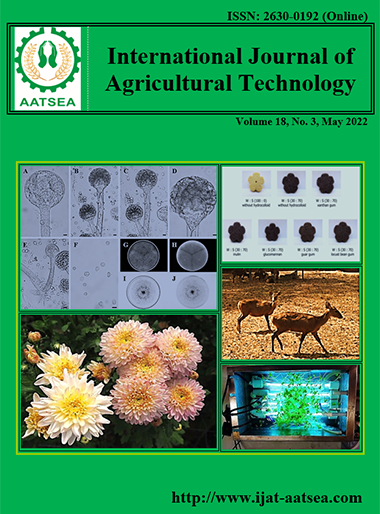Micropropagation of young inflorescence Curcuma hybrid In vitro
Main Article Content
Abstract
Five cultivars of curcuma hybrid consisted of 3 Paracurcuma and 2 Eucurcuma young inflorescences were cultured on MS medium supplemented with 0, 0.5 and 1 mg/l NAA and BA for 8 weeks. It was found that young inflorescences Paracurcuma hybrid Curcuma ‘Yuki’ cultured on MS medium supplement with the 1 mg/l NAA and 0.5 mg/l BA were able to induce the most shoots at 2.67 shoots, with the highest percentage of shoots (80.00%) and the average plant height is 5 cm. For Curcuma ‘Burgundy’ and Curcuma ‘Phonphisit’ cultured on MS medium supplement with 1 mg/l NAA and 1 mg/l BA, they were able to induce the most shoots at 1.66 and 1.78 shoots, the highest percentage of shoots is 73.33 and 76.67% respectively and the average plant height is 5 cm. The other cultivars Eucurcuma consist of Curcuma ‘Sweetmemory’ and Curcuma ‘Banrai Red’. The young inflorescences were divided into 2 parts, the upper and the lower one. The result shows that the lower shoot induction is better than upper one. Curcuma ‘Sweetmemory’ grown on MS medium supplemented with 0.5 mg/l NAA and 0.5 mg/l BA were able to induce the most shoots at 2.38 shoots, and the highest percentage of shoots is 83.33%. Curcuma ‘Banrai Red’ grown on MS medium supplemented with 0.5 mg/l NAA and 1 mg/l BA were able to induce the most shoots at 1.98 shoots, the highest percentage of shoots is 63.33% and both cultivars were the same height average at 5 cm.
Article Details

This work is licensed under a Creative Commons Attribution-NonCommercial-NoDerivatives 4.0 International License.
References
Adriance, G. W. and Brison, F. R. (1955). Propagation of Horticultural Plants. New York: McGraw Hill Book Company Inc., pp. 298.
Ahmed, E. U., Hayashi, T. and Yazawa, S. (2004). Auxin increase the occurrence of leaf-colour variants in Caladium regenerated from leaf explants. Scientia Horticulturae, 100:153-159.
Bharalee, R., Das, A. and Kalita, M. C. (2005). In vitro clonal propagation of Curcuma ceasia Roxb. and Curcuma zedoaria Rosc.from rhizome bud explants. Journal Plant Biochem Biotechnol, 14:61-63.
Brock, T. C. and Kaufman, P. B. (1991). Growth regulators: an account of hormone and groeth regulation. London: Growth and Development. Academic Press Inc., pp.277-340. In F.C. steward (ed.). Plant Physiology: A Treatise.Vol 10.
Bunya-atichart, K., Ketsa, S. and Van Door, W. G. (2004). Postharvest physiology of Curcuma alismatifolia flowers. Postharvest Biology and Technology Biharean Biologist, 10:134-136.
Ferdous, M. M., Shahinozzaman, M., Faruq, M. O., Paul, S. P., Azad, M. A. K. and Amin, M. N. (2012). In vitro propagation of a medicinal plant – mango ginger (Curcuma amada Roxb.). International Journal of Biosciences, 2:166-172.
Jafari, A., Kahrizi, D. and Mansouri, M. (2016). Effects of plant growth regulators and explant on callus induction in pennyroyal (Mentha pulegium L.). Biharean Biologist, 10:134-136.
Jala, A. (2012). Effects of NAA BA and Sucrose on Shoot Induction and Rapid Micropropagation by Trimming Shoot of Curcuma longa L. Thammasat International Journal of Science and Technology, 17:54-60.
Jala, A. (2014). Effect of Paclobutrazol and BA on Micropropagation in Curcuma sp. In vitro. Thai Journal of Science and Technology, 3:15-22.
Kakani, A., Li, G. and Peng, Z. (2009). Role of AUX1 in the control of organ identity during In vitro organogenesis and in mediating tissue specific auxin and cytokinin interaction in Arabidopsis. Planta, 229:645-657.
Kaviani, B., Hashemabadi, D., Khodabakhsh, H., Onsinejad, R., Ansari, M. H. and Haghighat, N. (2015). Micropropagation of Begonia rex Putz. by 6-benzyladenine (BA) and α-naphthalene acetic acid (NAA). International Journal of Biosciences, 6:8-15.
Mujib, A. Banerjee, S., Fatima, S. and Ghosh, P. D. (2008). Regenerated plant populations from rhizome-calli showed morphological and chromosomal changes in Caladium bicolor (Ait.) Vent. cv. Bleeding heart. Propagation Ornamental Plants, 8:138-143.
Murashige, T. and Skoog, F. (1962). A revised medium for rapid grow and bioassay with tobacco tissue culture. Plant Physiology, 15:473-497.
Nasirujjaman, K., Uddin S., M., Zaman, S. and Reza, M. A. (2005). Micropropagation of Turmeric (Curcuma longa Linn.) through In vitro Rhizome Bud Culture. Journal of Biological Sciences, 5:490-492.
Prathanturarug, S., Soonthornchareonnon, N., Chuakul, W., Phaidee, Y. and Saralamp, P. (2005). Rapid micropropagation of Curcuma longa using bud explants pre-culture in thidiazuron-supplemented liquid medium. Plant Cell Tissue Organ Culture, 80:347-351.
Salakpetch, S. (2020). Export Statistics of curcuma sp. Retrieved from http://technologychaoban.com/bullet-news-today/article_141745.
Skoog, F. and Miller, C. O. (1957). Chemical regulation of growth and organ formation in plant tissue cultured In vitro. Symposia of the Society for Experimental Biology, 11:118-130.
Someyo, S. and Authlungrong, A. (2020). The pathumma production. Retrieved from https://www.doa.go.th.
Zulkarnain, Z., Kartika, E. and Lizawati, L. (2019). Growth and development of young mail inflorescences of oil palm (Elaeis guineensis Jacq.) in tissue culture system: the effect of 2,4-Dichlorophenoxyacetic acid. Annual conference on environmental science, Society and its application. IOP Publishing, 1-7.


